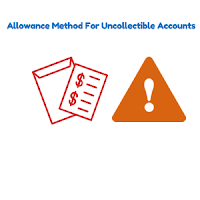Allowance Method For Uncollectible Accounts Or Doubtful Debts And Bad Debts Expense
Under Allowance Method, we estimate (based on Accounts Receivable Aging Report) that a percentage of Accounts Receivable may not be recovered from our customers. So we record the Accounts Receivable at net realizable value (Calculated by deducting the Closing Balance of Allowance
for Doubtful Accounts From Closing Balance of Accounts Receivable) on Balance Sheet in order to give true and fair view of Financial Statements to the Users of Financial Statements. Under this approach, we basically follow Matching Principle Gaap which is the requirement of Generally Accepted Accounting Principles (GAAP) that matched our expenses with revenues, i.e., Matching Sales with Uncollectible Accounts Expense. This Method is also Known as Provision Method, Projected Write Off Method or Specialized Write Off Method.
 For Example, if we sold goods worth Rs. 30000 to Mr. A on 1st July, 2108, unpaid amount collectible in 2 months, then based on past experiences, we estimate that 2% of the Account Receivable may not be recovered from our customer in time, so we record the following Adjusting
Journal Entry in the book of the business as shown below:
For Example, if we sold goods worth Rs. 30000 to Mr. A on 1st July, 2108, unpaid amount collectible in 2 months, then based on past experiences, we estimate that 2% of the Account Receivable may not be recovered from our customer in time, so we record the following Adjusting
Journal Entry in the book of the business as shown below:Allowance Method Journal Entry
Allowance for Doubtful Accounts a/c 600
(Recorded An Allowance of 2% On Account Receivable)
At the end of Current Accounting Period, we transfer the Ending Balance of Allowance for Doubtful Accounts to Balance Sheet and close the account of Uncollectibe Accounts Expense by transferring to Income Statement / Profit And Loss Account.
You May Also Like, "Direct Write Off Method"
You May Also Like, "Direct Write Off Method"
The process of making adjusting entry for the Uncollectible Accounts continue and we pass it for the our customers until full amount of dues paid or when it is sure that Uncollectible
Accounts become Uncollectible Accounts Expense or Bad Debts Expense Accounts. When, the unpaid dues becomes Bad Debts, we pass the following Accounting Journal Entry in the Book or Journal of business by considering the above example and suppose that Rs. 300 becomes Bad Debts:
Uncollectible Account Expense a/c 300
Accounts Receivable a/c 300
(Amount of Unpaid Dues Become Uncollectible Expense or Bad Debts Written Off)
It is to be noted that when unpaid dues become Bad Debts Written Off, still there are possibilities that our customer can pay in future and it is a Recovery of Bad Debt.
Why Does GAAP Require An Allowance Method For Uncollectibles?
Because, if we do not match our Revenues i.e., sales made on credit basis with the Expenses i.e., Uncolletible Accounts Expenses during the Current Accounting Period, then Accounts Receivable overstates and estimated sales will increase that leads to more Net Income. While in actual real fact is that it may happen that some unpaid invoices remains unpaid after due date. So, in a safe way, there is a need to Allowance For Uncollectible Accounts, so that Accounts Receivable should be shown on Balance Sheet at Net Relizable Value, so that Financial Statements show reliable, true and fair view information to the Users of Financial Statements.
So, under allowance method, we adjust the value of Accounts Receivable by deducting Contra Asset Account i.e., Allowance for Doubtful Accounts in order to give true and fair view and reliable Position of Accounts Receivable to the Users of Financial Statements. Also, this system is suitable for Accrual Basis of Accounting as most of the sales are made on Credit Basis as in case of Manufacturing Concerns that ordered raw material and goods on credit basis.
Comments